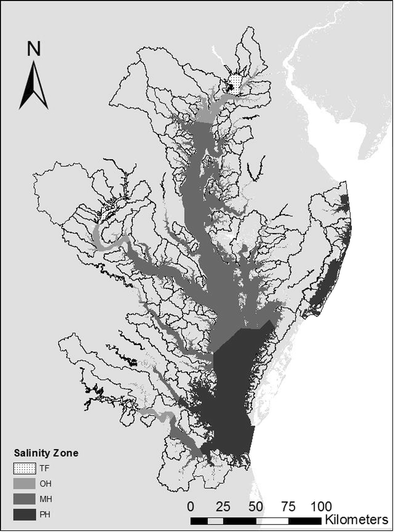A recent studysponsored by NCCOS found that submerged aquatic vegetation (SAV) in the saltier (and more southern) portions of Chesapeake Bay decreases in areas nearhardened shorelines.Shoreline hardening is anattempt to stabilize coastal land and protect residential and commercial infrastructure along the coast by building structures, like bulkheads, to hold back the sea and prevent the loss of sediment.

The major salinity zones in the Chesapeake Bay supportdifferent species of SAV, with different tolerances to reductions in light and the quality of sediments - two factors that shoreline hardening can affect. (TF = Tidal Fresh, OH = Oligohaline, MH = Mesohaline, PH = Polyhaline.) Credit: D. Weller, Smithsonian Environmental Research Center.
The major salinity zones in the bay havedifferent species of SAV, with different tolerances to reductions in light and the quality of sediments - two factors that shoreline hardening can affect. The researchers found that the negative effects of shoreline hardening were most evident in SAV species in the polyhaline (high salinity) zone.
Adjacent land use also influences the negative effectsof shoreline hardening. Considering salinity and land use together revealed the greatest reduction in SAV along hardened shorelines in the saltier subestuaries with forested land.Shoreline hardening had little effect on adjacent SAV coverage where landwasdominated by agriculture and development because water quality in those subestuaries was already too low to support SAV.
Natural resource managers can use these results to tailor management techniques to particular watersheds and their shorelines. The study, conducted by the Smithsonian Environmental Research Center, is published in the January 2016 issue of Estuaries and Coasts .
For more information, contact Elizabeth.Turner@noaa.gov.
 Official websites use .gov
A .gov website belongs to an official government organization in the United States.
Official websites use .gov
A .gov website belongs to an official government organization in the United States. Secure .gov websites use HTTPS
A lock or https:// means you’ve safely connected to the .gov website. Share sensitive information only on official, secure websites.
Secure .gov websites use HTTPS
A lock or https:// means you’ve safely connected to the .gov website. Share sensitive information only on official, secure websites.